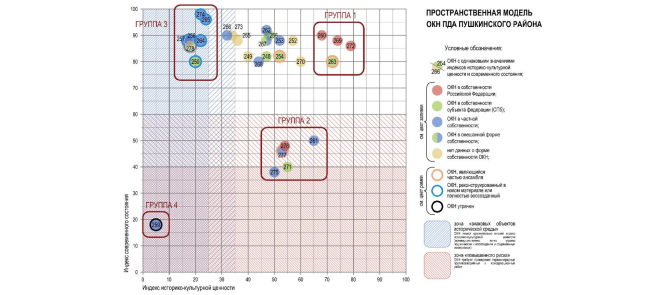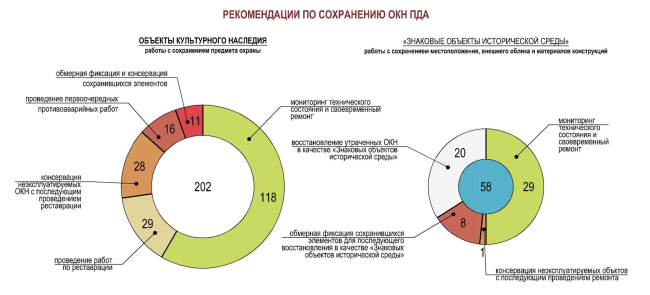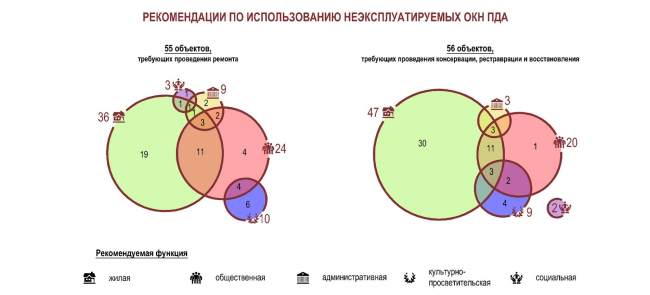|
Published on Archi.ru (https://archi.ru) |
|
| 30.05.2019 | |
|
Saving the Woodwork: Saint Petersburg |
|
|
Alyona Kuznetsova |
|
| Studio: | |
| Company: | |
|
Studio 44 has developed a concept of preserving the monuments of wooden architecture of Saint Petersburg. What is particularly interesting about this project is the method of determining the value of buildings, as well as a parametric model that vividly shows which buildings must be saved on a first-priority basis. Restoration of the Dobbert Manshion and adjusting it for the needs of Eifman Dance AcademyCopyright: © Studio-44The task of developing the concept of preserving Saint Petersburg’s monuments of wooden architecture was commissioned to Studio 44 by the city council. Saint Petersburg had long since been in a desperate need of one: according to experts, it was high time to get down to this part of the city’s historical legacy, the number of its wooden buildings shrinking by the year. If we are to speak on a national scale, within a 20-year span, Russia loses about 400 monuments of architecture, and these figures must be still greater for background construction. We cannot help mentioning the Church of the Assumption that burned down less than a year ago in Kontupohja. According to reports, in Saint Petersburg something is aflame virtually every month. There have already been some attempts to improve the situation: a few years ago the Ministry of Culture ordered a detailed concept for the entire country, while Saint Petersburg came up with the concept of developing the Kurortny Area, including preservation of the wooden buildings. Regretfully, none of these initiatives were to be implemented. In its concept, Studio 44 seems to start small – seemingly, what the architects are proposing is not even a concept but rather a survey and systematization of all the existing data. However, this meticulous approach to making even the first step is exactly what you need to avoid getting overwhelmed by the sheer scale of the task. The authors of the concept – a group of young architects and restoration specialists working under the guidance of Grigori Ivanov – were consulted by the member of the International Council of Monuments and Sites of Saint Petersburg, Candidate of Sciences in architecture, Boris Matveev. At the defense of the concept, the reviewer was the member of the Council for Protection of Cultural Heritage of Saint Petersburg, the author of numerous books on the history of wooden architecture, Mikhail Milchik. So, the first stage was about collecting the data. Totally, Saint Petersburg has 271 wooden buildings that bear a protected status, almost half of them located in the Kurortny and Petrodvortsovy areas with just a handful of surviving wooden buildings in the city center. The restoration experts of Studio 44 not only perused old documents and archives but also went to see each and every building in order to do on-site survey, evaluate the state this or that building was in, and make relevant photos. The current category of the historical and cultural heritage sites. The concept of preserving cultural heritage sites – monuments of wooden architecture in Saint PetersburgCopyright: © Studio-44As a result, each building got a card assigned to it that contained all the currently available information about this building. Such “passport” can become a starting point for further work because it provides an objective and rather detailed profile of the building. The card consists of seven blocks, the first four of which systematize the already available data: trivia, historical information – how many times the house was rebuilt – as well as the evaluation of its authenticity; the modern state and the section devoted to the technical and economic features can be interesting to investors and developers. The last three sections are of a “design” character: they include suggestions on saving, an attachment with photos 2018 with iconography, as well as the evaluation sheet. The latter is particularly important – it evaluates the monument of architecture in accordance with the method developed by Studio 44. Below, we shall describe it in more detail. To ensure objective evaluation of an architectural monument, the architects decided to introduce two indexes: one of historical and cultural value, and one of the current state, which is formed as a sum total of a number of sub-indexes. For example, the historical and cultural value of the building is measured by its authenticity, memorial, architectural, and historical value. Each of these for criteria are assigned points scoring from 0 to 100, this figure also depending on a number of factors. For example, the total “authenticity” score is calculated based on four UNESCO-approved aspects: authenticity of material, mastery of execution, original design, and surroundings. A maximum on each criterion is 25 points. Further on, the points for each criterion are multiplied by the criterion’s “weight”. In the total score, authenticity has 40% of “shares”, all the other criteria owning 20% each. In the index of current state, 40% are owned by the technical condition, and 20% are owned by character of operation, building services, and accessibility. The historical and cultural value of monuments of wooden architecture. The concept of preserving cultural heritage sites – monuments of wooden architecture in Saint PetersburgCopyright: © Studio-44The current state of monuments of wooden architecture. The concept of preserving cultural heritage sites – monuments of wooden architecture in Saint PetersburgCopyright: © Studio-44These indexes determine the situation of the monument in the frame of reference, where x is the historical and cultural value, and y is its current state. How specifically this space model visualizes the state of affairs with saving the monuments of wooden architecture, one can see on the example of the Pushkinsky district model. The district is subdivided into four groups of monuments of wooden architecture. In the first group, both indexes (the historical/cultural value and the current state) are high – such buildings are doing very well, in fact; all they need is monitoring. In the third group, the technical condition of the buildings is acceptable but their value as such is pretty low – such buildings do not require any urgent measures either. In the fourth group, both indexes are low – and the feasibility of restoring such buildings is subject to discussion. And, finally, it is the second group that requires most of attention because these houses are of high value but their technical condition puts them in the risk zone. The space model of the Pushkinsky District heritage sites. The concept of preserving cultural heritage sites – monuments of wooden architecture in Saint PetersburgCopyright: © Studio-44The model helps to define the priority of work; it is flexible; changes in the indexes influence the position of the monument in the frame of reference. In accordance with these indexes, the architects developed a block of recommendations for each monument, and it also has some very interesting nuances about it. For example, the architects are proposing to introduce a new legal term that sounds as “valuable object of historical environment”. Such objects can include buildings that are lost but recommended for restoration, or replicas that were built as such restoration projects, which is essentially new construction. This will help to define what’s authentic and what’s important, at the same time protecting newly built replica buildings, whose value is chiefly about creating a background for the integrated city context. Of course, the restoration of lost buildings must be governed by rigorous rules and regulations pertaining to their location, building materials, construction, appearance, and so on. Recommendations of fedral protection measures. The concept of preserving cultural heritage sites – monuments of wooden architecture in Saint PetersburgCopyright: © Studio-44Recommendations of fedral protection measures. The concept of preserving cultural heritage sites – monuments of wooden architecture in Saint PetersburgCopyright: © Studio-44Recommendations of fedral protection measures in respect to unused monuments of wooden architecture. The concept of preserving cultural heritage sites – monuments of wooden architecture in Saint PetersburgCopyright: © Studio-44According to one of the key developers of this concept, Ilia Sabantsev, there is an opportunity to create a whole open air museum of wooden architecture in Lomonosov, in the area of the Eleninskaya Street. It scores as many as eight monuments, three of which were lost but can be restored based on the available iconographic materials. Also, there is information about two lost houses that did not have the monument status but they could also be restored in order to give the project more momentum. Yet another proposal of this concept is to make an amendment to the existing legislation that restoration of monuments of wooden architecture could be privately funded, and to come up with a system of tax deduction for the investors. Working on this concept, the architects found out that almost half of the buildings were not used in any way, a quarter of them is all but lost, and about 55 buildings are in need of urgent repair. The current state of monuments of wooden architecture. The concept of preserving cultural heritage sites – monuments of wooden architecture in Saint PetersburgCopyright: © Studio-44The leader of Studio 44, Nikita Yavein, says that this concept is part of a bigger work. This concept is rather a systematic survey, the first tool for the State Inspectorate for the Preservation of Monuments, businessmen, and developers. In addition, he stresses that this method is only applicable for Saint Petersburg that does not have any monuments of wooden architecture in the traditional meaning of the term, and whose oldest wooden building is the house of Peter the Great. The concept was presented at a board meeting of the Council for Protection of Cultural Heritage, where it got a positive feedback from the experts and the approval of the alternate governor of Saint Petersburg, Alexander Beglov. The next stage will be about developing some specific programs on the basis of the drawn conclusions. |
|








